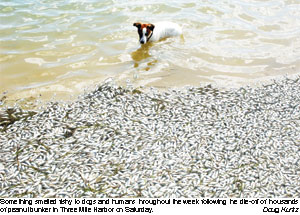A Bad Day for Bunker, and Noses, Marauding bluefish drove tens of thousands of menhaden to their deaths

Tens of thousands of juvenile menhaden - known as peanut bunker - died in the shallow water of a narrow channel at the northeast end of Three Mile Harbor on Friday night or Saturday morning. Eighty-degree weather quickly turned the scene into an olfactory nightmare.
Carol Hayes, who lives in the neighborhood, was walking around Maidstone Park as usual on Monday with her friends, Diane and Brittany Emery of Medford, N.J., and Kristin Womack, who was visiting from Mississippi. "We can't do it. We can't go all the way around. It's worse today," Ms. Hayes said, after hitting a wall of putrescence carried on a stiff, southwest wind.
"You get used to it, but then there's a gust of wind and you get a big whiff," said Elise Thorsen, an East Hampton Town lifeguard whose stand was stationed a quarter-mile away from the die-off, but directly downwind.
"It looked like silver snow," said Ken Rafferty, a light-tackle fishing guide who keeps his boat at Sunset Cove Marina, not far from where the mass of shiny-sided fish were heaped along the shore.
Bill Taylor, the town's waterways management supervisor, said it appeared that a school of bluefish had chased the peanut bunker into warm, shallow water, where they quickly used up the available oxygen.
"It's a dead end up there. On Saturday, we could see that many of them were bitten. We saw other kinds of fish swimming happily," Mr. Taylor said, meaning that the mass killing was probably a solitary event unrelated to problems with the water itself. "Between their excitement, the water temperature, and the shallow water - we've sent a sample of the water away to be tested anyway."
Also called mossbunker, pogy, or fat back, bunker swim in large schools made up of hundreds and thousands of silver-sided individuals. They feed on microscopic plants and the smallest crustaceans, which they filter from the water with comblike gill rakers. Adults grow to about a foot in length. This "industrial" species was, and continues to be, harvested for its oil and for animal feed, and was processed for many years at the Smith Meal plant at Promised Land on Napeague.
The oily fish are the favorite prey of a great number of species including whales, dolphins, sharks, pollack, cod, and swordfish. But, according to the "Fishes of the Gulf of Maine," bluefish are the bunkers' "worst enemy."
"Not only do these pirates devour millions of menhaden every summer, but they kill far more than they eat . . . Menhaden often strand in myriads in shoal water, either in their attempt to escape their enemies or for other reasons, to perish and pollute the air for weeks with the stench of their decaying carcasses," the book states.
By yesterday, tide and birds had removed most of the peanut bunker carcasses, but their spirit remained in the air. "There's less of them, but they smelled a lot worse," Mr. Taylor said.
